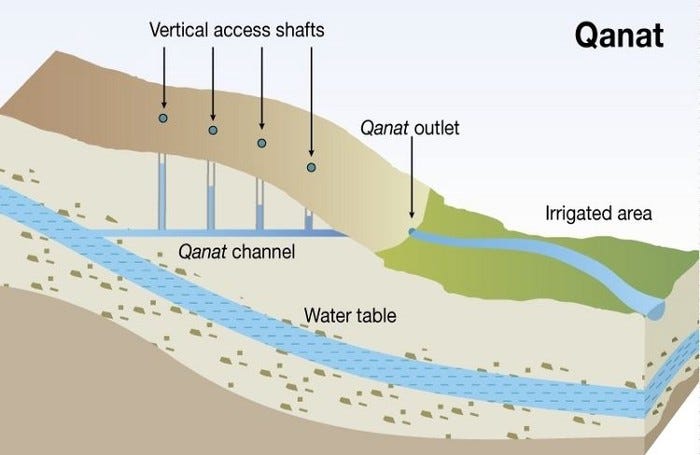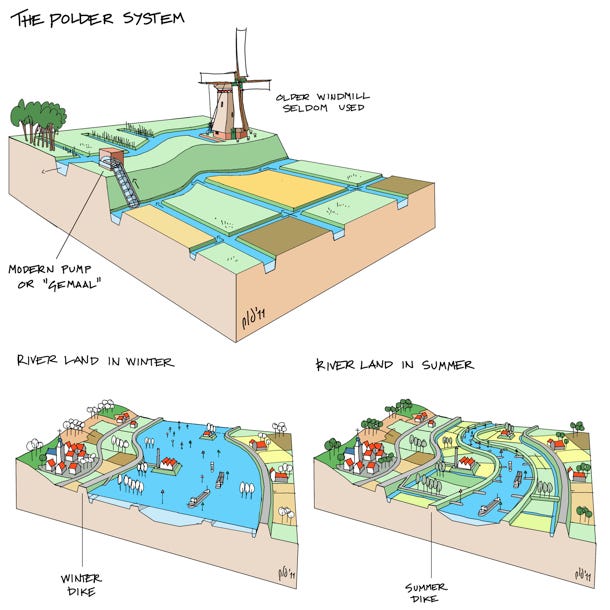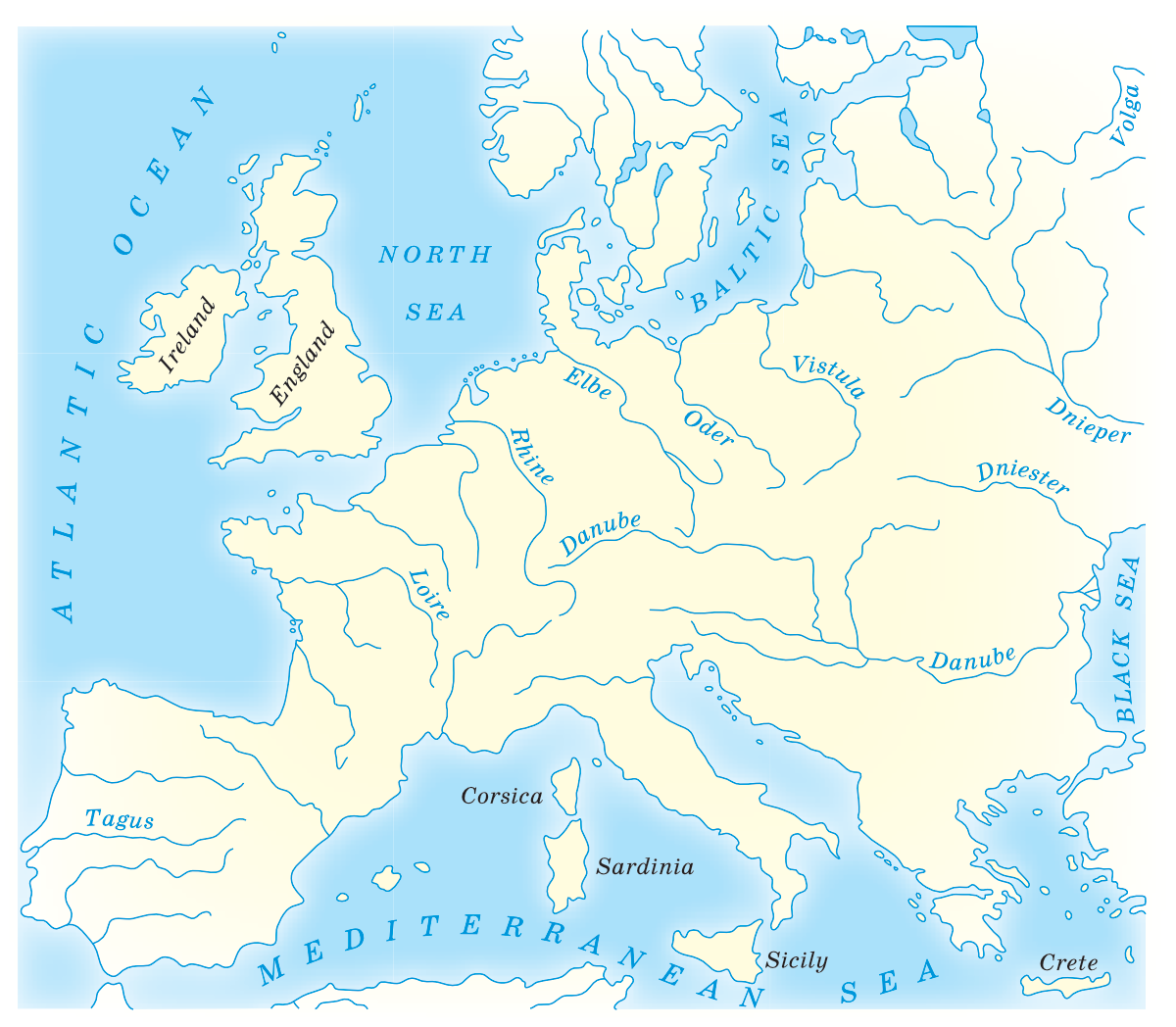How Climate and Geography Shaped Scandinavian Prosperity and Democracy
Why did Scandinavia become so much more prosperous than Southern and Eastern Europe and more egalitarian than Western Europe?
This is a story about how the unique landscapes, climates and geography of Scandinavia played a key role in shaping Scandinavian society and create the conditions for success.
A central character in this story is water. Water is at the heart of human civilization. We need it to drink, water our plants, transport goods on ships and it was our first source of inanimate power (water wheels).
Despite the crucial role water plays in shaping human civilization it is rarely talked about. Instead you will hear famous sociologists such as Max Weber talk about Protestant work ethic, others like geographer Jared Diamond talks about how plants and domesticated animals spread.
Let me give you an idea of why water is so important:
Shipping a sack of sugar from Havana, Cuba across the Atlantic by ship to Oslo, Norway in the 1800s was cheaper than sending that same sack of sugar a mere 50 kilometers from Oslo to Eidsvoll by horse and carriage.
Here is another example: Until 1820 the British industrial revolution was almost entirely driven by waterwheels. Most people today are unaware of this fact. They think the industrial revolution was all about steam engines. Yes, steam engines arose during the industrial revolution, but most of the factories were in fact powered by waterwheels.
That Manchester became the manufacturing hub of Great Britain was no accident. The surrounding area had numerous rivers with enough fall to support hundreds of waterwheels powering a great variety of mills and factories.
But water does not shape societies in the same manner. One might go as far as to say that water can be autocratic or democratic. Okay, that sounds corny. What I mean is that the way water is accessible and used in different societies will tend to push societies either towards a hierarchical autocratic power structure or a more egalitarian and democratic power structure. Outcomes depend on things like scarcity of water. Does society have too little water or is there too much and there is a great need for drainage systems?
To understand how water shaped Scandinavian history and development, I want to have something to contrast Scandinavia with. Thus, this story will begin with ancient civilizations such as Egypt, Sumer, China, Indus and Persia. These civilizations arose very early and have cultures which are almost the complete opposite of Scandinavian culture. While Scandinavian societies tend to be egalitarian and democratic, the countries which served as the birth places of the first great civilizations tend to have deeply hierarchical and autocratic power structures.
Social psychologist Geert Hofsted has developed a cultural dimension theory, which is used to rate different cultural traits. One of these is the power distance index, which says something about how strong power hierarchies are in different cultures. You can see how the classic river based civilizations have high scores for hierarchy (around 80) while Nordic countries are below 40.
Note: I am using Arab countries instead of Egypt and Iraq in this measurement because Egypt and Iraq has no data for hierarchy.
How Rivers Built the First Great Civilizations
In areas such as Egypt, Mesopotamia (current Iraq), Indus valley (present day India) and China civilizations grew up along vast rivers such as the Nile, Euphrates, Tigris, Indus, Yangtze
These vast river systems would flood the river banks and deposit silt which would act as fertilizer. The hot climates allowed for multiple harvests through the year. This combination gave very rich harvests and made it possible to create population dense civilizations since large amounts of food could be produced within a small area. The rivers themselves gave opportunities to transport goods.
Here are some important things to note about water access in these areas: It rarely rains, so the river is crucial in accessing water. However, rivers are not exactly playing along with humans. They flood huge areas. Humans had to tame these rivers with complex systems of canals and dams.
That way water could be led to areas where it was needed while avoiding the flooding of cities or other settlements. Water could be kept in storage to water lands over longer period of time. Water could be led further away from the river to expand agricultural areas.
Managing these water systems required a lot of planning, labor and central administration. This gave rise to powerful centralized states. Egypt, Sumer had God-like rulers. The Emperors of China were also almost likened to Gods. Their power was immense.
Water management was a key reason for this immense power. These rulers basically held a gun to the head of every farmer. Should the farmers not play ball, they would not get their needed share of water from the centralized irrigation, canal and dam system that had been built up.
Whenever China collapsed into multiple states, food production dropped like a stone. The reason was simple: Maintaining all the complex network of canals required vast amounts of coordination and manpower over a large area. Such work could only be done by a large powerful state.
For this reason China would through history never stay divided for long. There would always be an immense pressure to re-unite China into one empire, as this always meant a dramatically improved agricultural production.
Qanat and Aqueduct Civilizations
All ancient civilizations were not built around huge rivers. Persia, Ancient Rome and Greece was not built around major rivers.
However all these civilizations existed in areas with a lot of mountains. These civilizations built systems to carry water from the mountains down to the agricultural areas.
Aquifers are create storage of water underground. However you should not think of these as some kind of large caves with water inside. Instead they are much like oil reservoirs except they hold water. At the bottom you have an impermeable rock formation which traps the water. Above you have porous rocks such as sandstone which contains numerous small empty spaces which allows water to be stored.
Persians developed a kind of underground aqueduct called qanat which would transfer water from mountain aquifers to agricultural areas. Qanats evolved from mining operations. Anyone doing mining will discover major problems with water underground. The Persians figured out they could dig tunnels to lead the water from these mines down to the lowlands and water their farm fields.
By digging shafts at regular intervals they could get access to the underground and dig the tunnels for many kilometers. Because the water is running underground you avoid water evaporation which would be a big problem in hot areas like Persia.
Iran since ancient times is riddled with Qanats. Reading up about this I am a bit surprised that they are not as well known as Aqueducts because they have been used all over the world. The technique spread to Moorish Spain. Both Teheran and Madrid did until modern times get all their water from Qanats.
They also ended up getting used in Italy as well as in ancient Greece. While they seem similar to Aqueducts the key difference is that Qanats are dug deep under ground and source water from an Aquifer in the mountains. Aqueducts are laid in pipes in shallow ground or above ground on top of great arches. They source their water from rivers or lakes in the mountains.
Both of these systems require large groups of people to work together and coordinate their actions. Thus while qanat and aqueducts are not rivers they still lead to similar need for centralized government and control. Another way of looking at it is that government can more easily control water access when this is how you get water as opposed to from rain from the sky.
But why live in areas which requires this complex water management? A benefit is that in these hot climates you can grow a greater variety of crops and harvest multiple times per year. Until the development of the heavy plow which could be used to deal with the heavier soil in Northern Europe, these hotter areas gave significant advantage in terms of agricultural output.
Rainfall Civilizations
Go further north and you get to lands where there is enough rain to water the crops. Complex engineering and water management systems are not needed. That applies to countries such as Germany, France, Great Britain, Netherlands, Baltics, Ukraine, Russia and the Nordic countries.
In fact northern countries would often face the opposite problem: Too much water. Farmers would have to spend a lot of effort to build drainage ditches. The Netherlands is a rather extreme example. Because the Netherlands is below sea level, the ground is very close to the water table. The result is that managing agriculture in the Netherlands is a constant challenge of drainage.
There is a joke about how God created the world but the Dutch created Netherlands. It derives from that fact that so much of the Netherlands is land reclaimed from the sea. They would build dikes out in the sea. Once and artificial lake is created they would drain it using windmills driving pumping systems. However draining these polders is a constant activity.
The Dutch call the area below sea-level which is surrounded by dikes a polder. A polder could be large enough to hold several towns. Political power within this context developed opposite of what we found in the great river civilizations and those based on qanats and aqueducts. An army or a powerful ruler could hold a gun to the head of every farmer by blocking the water flow.
A polder is the opposite. Everybody must maintain the dike they live next to or everybody dies from flooding. It is a bit like the cold war concept of mutually assured destruction (MAD).
It is a like everybody holding a gun to the head of everybody else. The only way to deal with such as situation is mutual respect and cooperation. That is how the Dutch waterboards arose. People from the whole area covered by a waterboard would elect representatives which would implement policies related to water management which all towns within the waterboard area. Waterboards served as the model for the development of Dutch democracy.
Thus, unlike China and Egypt, water management in the Netherlands pushed for the development of Democracy rather than Autocracy.
The Netherlands is of course a rather unique case, so I will shift my attention to Denmark and Germany.
Coastal and River Based Trade Networks
Both Denmark and Germany have easy access to water from rainfall. Neither country has to manage large networks of dikes, so why did Denmark develop in a more egalitarian and democratic direction than Germany?
It is worth asking because Germany and Scandinavian countries share many cultural traits. Scandinavian traditions for how to organize bureaucracy education draws a lot of inspiration from Northern German states.
A key difference is how trade was conducted. The map below shows Denmark before 1645. Notice how much coastline there is relative to the landmass of Denmark. That implies that a large fraction of the Danish population had easy access to the sea and could uses it to transport goods to other parts of Denmark.
In Germany in contrast transportation of goods and people would be done along rivers such as Rhine, Elbe and Danube. Now it should be pointed out that Northern Germany has a very extensive network of waterways. The rivers help explain who Germany managed to develop so well. Rivers allow for more goods to be transported cheaply, which allows higher volume production and specialization.
So Denmark and Germany are fundamentally different in how water facilitates transportation. Denmark is well suited for ocean based transportation while Germany has very little coastline relative to its total landmass. Instead Germany has a lot of rivers.
A well known feature of the German landscapes are the numerous castles built along the rivers. With these castles the local lords could control commercial trade and traffic. Controlling ocean based trade by setting up castles does not work well. People can easily sail around those spots.
Thus the German aristocracy could control trade in a way Danish aristocrats and local rulers could not. Thus a more free and independent peasantry evolved in Denmark. They could more easily trade with each other without some kind of centralized power manipulating or controlling this trade.
A related condition developed in Norway. While the landmass of Norway is not split into multiple islands like Denmark, it has large number of fjords which gives Norway the longest coastline in Europe. That means a large fraction of the Norwegian population is also close to the ocean similar to Denmark. In addition Norway is mountainous with may rivers and streams. Historically these got used to float timber down to fjords so they could be loaded on ships and exported.
Flat vs Mountainous Terrain
In Norway it is the combination of mountains, forests and fjords which makes centralized control difficult. If you spread out people over a large area with difficult terrain, you cannot control them as easily as when they are concentrated in smaller flat area. For this reason in the Danish-Norwegian union Norwegian farmers actually had the most freedom and the lowest taxes.
In countries with flat terrain you tend to see the formation of authoritarian states. I have talked about Egypt and Mesopotamia as places where the water management systems contributed to centralized control.
Looking only at water management one would have assume that places like Russia should have developed into democracies given that Russia farmers get easy access to water through rain rather than complex water management systems.
However, large flat terrain makes it easy for large armies to move around, while making it hard defenders to protect themselves. Especially large plains without forests, hills or mountains cannot protect itself easily against powerful armies.
The Mongol conquests represent a good example of this. The large grass plains allowed their cavalry to cover large distances and conquer vast swats of land. If you look world maps you will see how mountainous regions tend to form separate countries such as Switzerland, Norway and Greece. Large flat plains tend to form large countries as natural borders don’t form across a plain.
Europe itself is a patchwork of states due to irregular coastlines, mountain ranges and rivers going in a variety of directions. Usually mountain ranges go in one direction. However Europe has been squeezed between several continental plates causing mountain ranges to go in different directions.
The Pyrenees create a natural boundary between Spain and France. Especially since the coastline is such that the land area narrows there. The Alps form a naturally boundary between Italy and the rest of Europe. The Rhein in combination with the Alps form a boundary between France and Germany.
Development of a Maritime Culture and Its Implication
To become a seafaring nation you need areas to practice. Greece could develop seafaring early because it has numerous islands and an irregular coastline. Being able to sail was thus clearly beneficial and you could accomplish getting to different places without too much difficulty.
The classic work by Homer, the Odyssey, gives a hint at the role seafaring played in early Greek history.
Greece is different from other ancient civilization in that it was not really based on bountiful agricultural production evolved from major river systems. Instead Greek power and prosperity was built on seafaring.
Remember my examples with how much cheaper sea based transportation is? Rivers are definitely useful but seafaring ships can more easily exploit strong winds and are thus better suited for transporting large amounts of cargo.
Say you were a God and had a lump of land you wanted to shape. How would you arrange the landmass to facilitate as much goods transport as possible? If you rolled the land into a blob or a circle, you would minimize trade. However if you split the land into numerous islands which are close to each other, you dramatically increase potential for trade. In effect you would have created Greece.

Greece could thus specialize on production of specialized good rather than aim for full self-sufficiency which is not always optimal. Greece used its land to produce olive oil and wine which it would export to get grain and meat from Egypt, Sicily, Carthage and other civilizations.
Keep reading with a 7-day free trial
Subscribe to Erik Examines to keep reading this post and get 7 days of free access to the full post archives.










